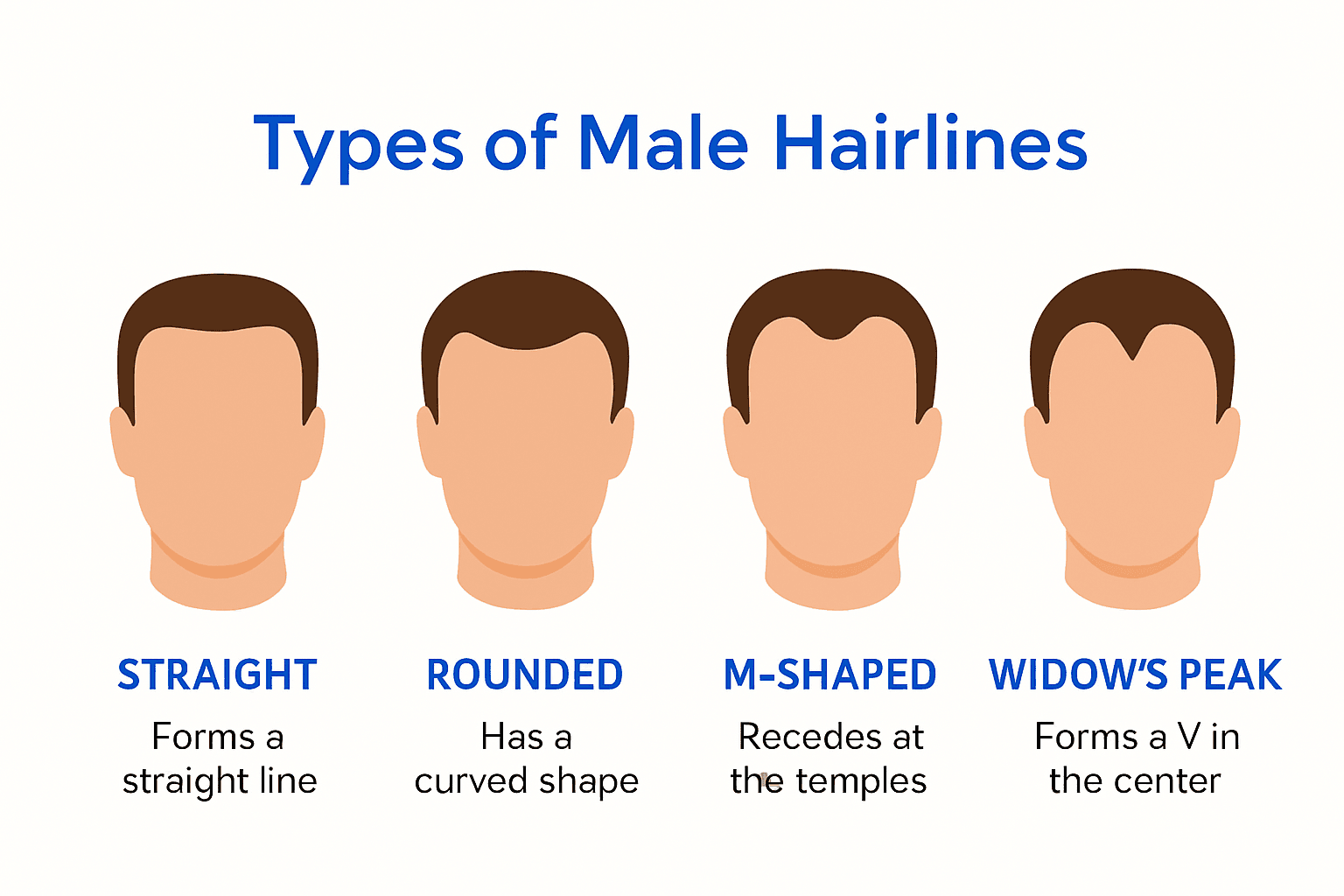Blog
Learning Materials
Male Hairlines in 2025: Causes, Patterns, and Best Solutions
Updated: June 7, 2025

Male hairlines are changing fast as scientists discover new patterns and causes every year. About 88.5 percent of all men have either a linear or M-shaped hairline yet changes in these shapes can signal major shifts in health and genetics long before most people notice. You might think hair loss only comes down to bad luck or family history but technology now brings early warning signs and tailored solutions most men have never seen before.
Table of Contents
- Understanding Male Hairline Patterns And Types
- Common Causes Of Changes In Male Hairlines
- Tracking Hair Growth And Early Signs Of Hair Loss
- Best Personalized Solutions For Restoring Male Hairlines
Quick Summary
| Takeaway | Explanation |
|---|---|
| Understand Hairline Patterns | Different hairline types, such as straight, rounded, M-shaped, and widow's peak, can indicate genetic predispositions and future hair health. |
| Monitor Early Signs of Hair Loss | Key indicators include temple recession, increased hair shedding, scalp visibility, and miniaturization, which signal the need for proactive intervention. |
| Leverage Advanced Tracking Solutions | Technological advancements provide tools for personal hair health monitoring, including digital photos and AI analysis for personalized growth projections. |
| Explore Personalized Restoration Options | Today's restoration techniques encompass stem cell therapy, PRP therapy, and robotic FUE, tailored to individual needs for effective recovery. |
| Incorporate Holistic Health Strategies | Effective hair restoration includes lifestyle changes, nutritional support, and stress management alongside medical treatments for comprehensive care. |
Understanding Male Hairline Patterns and Types
Male hairlines are complex biological features that reveal critical information about genetic predispositions, hormonal influences, and potential future hair health. Understanding these patterns goes beyond simple aesthetic considerations, providing insights into overall physiological changes men experience throughout their lifetime.
The Fundamental Types of Male Hairlines
Male hairlines are not uniform but exhibit distinct characteristics that can be categorized into specific patterns. Research indicates that linear and M-shaped hairlines represent approximately 88.5% of all male hairline configurations. These patterns are determined by multiple genetic and environmental factors.
Typically, male hairlines can be classified into several primary types:
- Straight Hairline: A uniform, horizontal line across the forehead
- Rounded Hairline: Soft curves with minimal sharp angles
- M-Shaped Hairline: Characteristic recession at the temples creating a distinctive "M" pattern
- Widow's Peak: A central point extending downward in the middle of the forehead

Progression and Classification of Hairline Changes
Understanding hairline progression requires recognizing standardized assessment methods. The Norwood scale, a comprehensive classification system, maps out 12 distinct stages of male pattern baldness. This scientific framework helps medical professionals and researchers track and predict hair loss trajectories.
The Norwood scale provides a systematic approach to understanding how male hairlines transform over time. It categorizes changes from minimal recession to complete baldness, helping individuals and healthcare providers anticipate and manage potential hair loss scenarios.
Key factors influencing hairline changes include:
- Genetic Predisposition: Inherited traits play a significant role in determining hairline characteristics
- Hormonal Influences: Testosterone and dihydrotestosterone (DHT) impact hair follicle behavior
- Age-Related Transformations: Natural aging processes affect hair density and hairline positioning
Temporal Hairline Dynamics
The temporal regions of the hairline are particularly susceptible to changes. Experts note that when temporal hairlines begin receding, they often create an M-shaped configuration. This pattern is distinct from a traditional widow's peak, representing a more pronounced recession at the sides of the forehead.
Understanding these nuanced patterns allows for more informed approaches to hair health management. Recognizing early signs of hairline changes enables proactive strategies in hair care and potential intervention methods.
By comprehensively analyzing male hairline patterns, individuals can gain deeper insights into their genetic makeup, potential future hair loss trajectories, and personalized care strategies. The intricate interplay of genetics, hormones, and environmental factors continues to shape our understanding of male hair health.
Common Causes of Changes in Male Hairlines
Male hairline transformations are complex phenomena influenced by an intricate network of biological, environmental, and lifestyle factors. Understanding these underlying causes provides critical insights into hair health management and potential intervention strategies.
Genetic Predispositions and Hormonal Influences
Research indicates that androgenetic alopecia, commonly known as male pattern baldness, affects up to 50% of men worldwide. This condition is predominantly driven by genetic factors that interact with hormonal dynamics.
The primary hormonal culprit behind hairline changes is dihydrotestosterone (DHT). Endocrinological studies reveal that high DHT levels can significantly impact hair follicle health by:
- Shrinking Hair Follicles: Gradually reducing the size and functionality of hair growth structures
- Shortening Growth Cycle: Accelerating the transition from active growth to dormant phases
- Hormonal Sensitivity: Triggering genetic predispositions for hair loss
Men over 40 often experience declining testosterone levels, which can further contribute to hairline recession and overall hair thinning.
Lifestyle and Environmental Factors
Beyond genetic programming, numerous lifestyle choices dramatically influence male hairline dynamics. Comprehensive health research has identified several critical external factors that can accelerate hair loss:
- Chronic Stress: Prolonged psychological stress triggers hormonal imbalances that disrupt normal hair growth patterns
- Nutritional Deficiencies: Inadequate protein, iron, and vitamin intake can compromise hair follicle health
- Medication Interactions: Certain pharmaceutical treatments may induce hair thinning as a side effect
- Significant Weight Fluctuations: Rapid weight loss or gain can shock the body's metabolic processes
- Smoking: Reduces blood circulation to hair follicles, impeding nutrient delivery
Medical Conditions and Hair Health
Certain underlying medical conditions can also precipitate changes in male hairlines. Autoimmune disorders, thyroid dysfunction, and scalp infections represent potential contributors to hair loss mechanisms.
Individuals experiencing sudden or unexplained hairline changes should consult healthcare professionals to rule out potential systemic health issues. Comprehensive medical evaluations can help distinguish between natural aging processes and more complex physiological disruptions.
Understanding these multifaceted causes empowers men to take proactive approaches in maintaining hair health. By recognizing the intricate interplay between genetics, hormones, lifestyle, and overall well-being, individuals can develop targeted strategies for managing potential hairline transformations.
The journey of understanding male hairline changes is not just about aesthetics but represents a deeper exploration of personal health, genetic inheritance, and individual physiological responses.
Tracking Hair Growth and Early Signs of Hair Loss
Identifying and monitoring hair loss progression requires a strategic and proactive approach. Understanding the nuanced indicators of potential hair health changes empowers men to take early action and develop personalized intervention strategies.
Early Detection Markers
Research from hair restoration experts indicates that a receding hairline represents a critical early indicator of potential hair loss. This phenomenon is primarily driven by androgens and genetic predispositions, making systematic tracking essential for comprehensive hair health management.
Key early signs of potential hair loss include:
- Temple Recession: Gradual pulling back of the hairline at temporal regions
- Increased Hair Shedding: Noticing more hair strands during washing or brushing
- Scalp Visibility: Growing transparency or widening of part lines
- Miniaturization: Hair becoming progressively thinner and shorter
Monitoring and Intervention Strategies
Advanced hair restoration techniques in 2025 emphasize early detection as a crucial component of effective treatment. Professional tracking methods now incorporate sophisticated digital scanning and AI-powered analysis to provide precise measurements of hair density and growth patterns.
Medical interventions have also evolved. FDA-approved medications like finasteride and minoxidil continue to be primary treatment options, with emerging formulations designed to target hairline recession more effectively. These treatments work by:
- Blocking DHT: Reducing hormonal impacts on hair follicles
- Stimulating Follicle Growth: Encouraging existing hair regeneration
- Preventing Further Recession: Stabilizing current hair density
Technological Tracking Solutions

Emergent technologies are revolutionizing how men monitor hair health. Digital platforms now offer comprehensive tracking systems that allow users to:
- Upload periodic scalp photographs
- Analyze hair density changes
- Receive personalized growth projections
- Get recommendations based on individual hair characteristics
These advanced tracking methods transform hair loss from an inevitable process into a manageable condition. By leveraging data-driven insights, men can now develop highly personalized strategies that address their unique hair health challenges.
Understanding your hair's specific growth patterns and potential loss trajectories requires a combination of professional medical insights, technological tracking, and proactive personal management. The future of hair health is no longer about accepting loss but strategically preserving and potentially regenerating hair growth.
Best Personalized Solutions for Restoring Male Hairlines
Personalized hair restoration strategies have transformed dramatically in 2025, offering men sophisticated, tailored approaches that go beyond traditional treatment methods. The future of male hairline restoration is defined by precision, technology, and holistic understanding of individual hair loss patterns.
Advanced Medical Interventions
Innovative medical technologies now provide an unprecedented range of personalized solutions for male hairline restoration. Cutting-edge techniques combine medical expertise with advanced diagnostic tools to create highly customized treatment plans.
Key medical interventions include:
- Stem Cell Therapy: Regenerative treatments that stimulate natural hair growth
- Platelet-Rich Plasma (PRP) Therapy: Using patient's own blood plasma to encourage follicle rejuvenation
- Robotic Follicular Unit Extraction (FUE): Precise, minimally invasive hair transplant techniques
Technological Personalization Strategies
Advanced imaging technologies in 2025 enable unprecedented levels of personalization. Digital scanning and AI-powered analysis create comprehensive hair health profiles that allow specialists to develop targeted restoration strategies.
Personalization methods now incorporate:
- 3D Scalp Mapping: Detailed analysis of hair density and growth patterns
- Genetic Profiling: Understanding individual predispositions to hair loss
- Predictive Growth Modeling: Forecasting potential hair restoration outcomes
Holistic Restoration Approaches
Cutting-edge research indicates that successful hairline restoration extends beyond medical interventions. Comprehensive strategies now integrate lifestyle modifications, nutritional support, and psychological considerations.
Holistic restoration approaches focus on:
- Nutritional Optimization: Targeted supplements supporting hair health
- Stress Management: Techniques to reduce physiological factors contributing to hair loss
- Personalized Scalp Care: Customized treatment protocols
The future of male hairline restoration is not about generic solutions but creating individualized pathways that respect each person's unique biological makeup. By combining advanced medical technologies, precise diagnostic tools, and comprehensive health strategies, men can now approach hair restoration with unprecedented confidence and effectiveness.
Each personalized solution represents a unique journey toward renewed hair health, acknowledging that true restoration goes far beyond simple cosmetic interventions. It's about understanding individual biological narratives and empowering men to take control of their hair restoration process.
Frequently Asked Questions
What are the common patterns of male hairlines?
Male hairlines can typically be classified into several patterns, including straight, rounded, M-shaped, and widow's peak, which represent about 88.5% of male configurations.
What causes changes in male hairlines?
Changes in male hairlines are influenced by a mix of genetic predispositions, hormonal influences such as DHT levels, lifestyle factors, and underlying medical conditions.
How can I detect early signs of hair loss?
Key early signs of hair loss include temple recession, increased hair shedding, scalp visibility, and miniaturization of hair strands. Monitoring these signs can help in taking proactive measures.
What are the best solutions for restoring male hairlines?
Effective restoration solutions involve advanced medical interventions like stem cell therapy and PRP therapy, technological personalization strategies, and holistic approaches that include lifestyle and nutritional support.
Discover Your Unique Hairline Future With AI Precision
Are you noticing subtle shifts in your hairline or feeling anxious about early signs like temple recession, thinning, or that stubborn M-shaped pattern that just seems to grow each year? No one likes the feeling of uncertainty about hair health. The good news is you don't have to wait and wonder. The latest science featured here shows that personalized monitoring and early action can make all the difference. At MyHair.ai, you get more than just hope. You get real answers, visual progress tracking, and product recommendations built for you.

Why wait and risk missing your optimal intervention window? Simply upload a few photos and let MyHair.ai’s advanced algorithms analyze your hairline patterns. Receive a detailed report with personalized growth projections and tailored hair care advice in minutes. Take control of your hair health journey today by visiting MyHair.ai and experience the confidence of early, AI-driven insight.
Recommended Articles
- Hair Treatment for Thinning Hair - Options & Guide 2025 | MyHair
- Bald Spot on Crown: Spotting, Causes, and Treatment | MyHair
- Simple Ways to Promote Hair Growth Naturally | MyHair
- Shea Moisture Hair Loss: Myths, Facts & 2025 Insights | MyHair
- Simple Hair Routine Guide: Daily Essentials and Expert Tips | MyHair